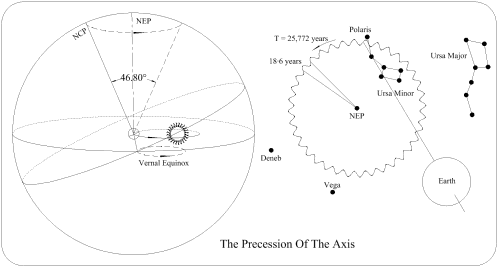
The Precession Of The Axis
The drawing shows the axis moving such that it traces a cone, & this movement is called precession. As the axis moves so must the equator, so the celestial equator nust move, hence the vernal equinox moves. This gives rise to the phrase "precession of the equinoxes" to describe this movement.
Superimposed on the precession is a wobble, called nutation. Precession & nutation are only the major effects.
The stars' coordinates are, therefore, constantly changing, & astronomers must regularly update them If the axis of the ecliptic was projected to the celestial sphere it would intersect it at the Ecliptic Pole, & coordinates referenced to that, ecliptic coordinates, would be much more stable. But the gravitational effects cause even that to move.
Apparent sidereal time must also be corrected if it is to define when a position on the Earth points to a star as it did one sidereal day before. The correction for nutation yields Mean Sidereal Time, MST: 23h 56m 4.090 530 832 88s.
The MST is used on the RA axis of telescopes & is the RA of stars & the vernal equinox in astronomical tables.
The drawing is self-explanatory apart from LHA, Local Hour Angle, & GHA, Greenwich Hour Angle.
The former is the difference in MST between any two points of interest, the latter the difference between a point of interest & Greenwich.
Next page: Astronomy Notes
Previous page: Astronomy 3
Howard's Stuff Index
Back to Pigeon's Nest
Be kind to pigeons